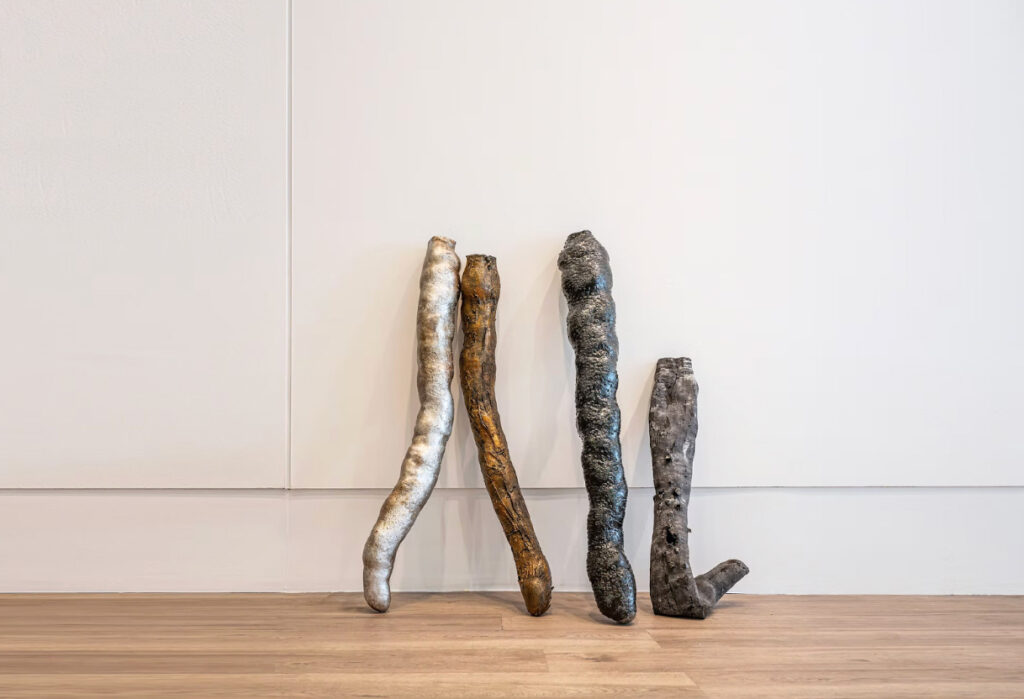
Exploring Fluidity and Materiality: Lacquer as Memory in the Work of MIAO Tan
Interviewed and written by Penelope Bianchi and Beata Li
Combining ancient lacquer techniques with flexible materials, Miao’s work investigates how memory, identity, and social norms harden over time—then peels them back to reveal fluidity beneath. Raised in China and now based in London, her practice is shaped by cultural dualities and a desire to reframe tradition through contemporary sensorial experience. Lacquer, a medium with deep roots in East Asian craftsmanship, serves both as material and metaphor—bridging body and object, memory and surface.
Miao Tan showcased her work They, Them, Their I at The Cold Magazine x Meng event back in December.
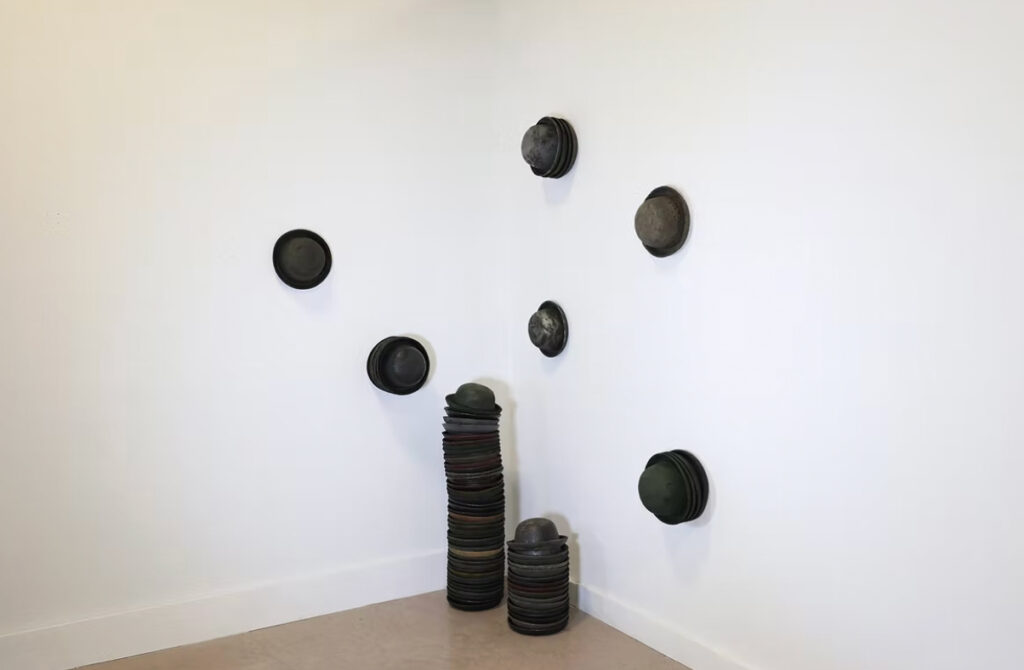
The Cold Magazine follows up with Miao Tan in this interview on her artistic development and co-founding qī qí qǐ qì(漆奇岂器) Studio with fellow RCA graduate Siying Cui.
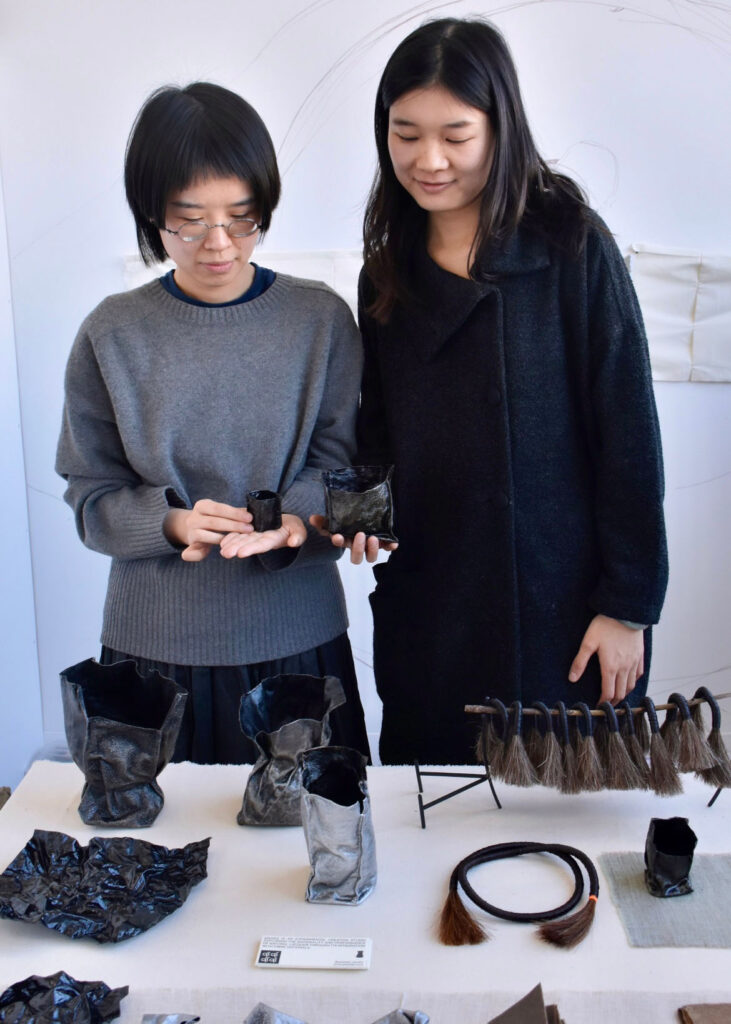
The Cold Magazine (CM): Tell us a bit about your background – how did your journey into the art world begin?
Miao (M): When I was really little, my mom took me to learn traditional calligraphy—my very first time handling a brush. Practicing for two hours every day was pretty boring, as I repeated the same strokes and characters over and over until they finally came together to form a complete poem. I remember a guest once saying that it was impressive for a girl to study calligraphy since there aren’t many famous female calligraphers, and he urged me to take it seriously. I didn’t quite get it back then—why were there so few women in calligraphy? Is there really any difference between girls and boys? That remark kept echoing in my mind, and I decided then that I wanted to become a great calligrapher. As a kid, I didn’t really know what “passion” meant; I just wanted to make a mark and work hard towards a clear goal.
In high school, I learned some exam-oriented painting skills like drawing, sketching, and colour theory. At that time, I hadn’t yet formed my own way of seeing the world or understanding art—I was just picking up techniques. Those skills eventually helped me get into a pretty good college where I studied oil painting.
College, however, still felt pretty dull. The courses were rigid, focusing mostly on figure drawing, still life, and sketching—basically, technical practice. Day after day, I passively absorbed these skills, striving to meet a certain standard. With only one type of medium and not much ability to explore or research, my view of painting became narrow, and I gradually lost interest. Then, in my sophomore year, everything changed in a mixed-media class. It completely shattered my old ideas about painting. I discovered that art could be so free and expressive! I started making collages with found objects, scraps of fabric, and even jewellery, sticking them onto walls. I felt confident and lighthearted, realising that painting wasn’t just about carefully detailing a flat surface—it could also be spontaneous, energetic, and liberating.
CM: How did your relationship with lacquer begin? What drew you to this material in the first place?
M: My fascination with lacquer began with the demolition of my childhood home in China. I was searching for a way to preserve its memory—not just through images, but something physical. The texture of lacquer reminded me of the walls: aged, glossy, full of time. It felt like the surface itself had lived.
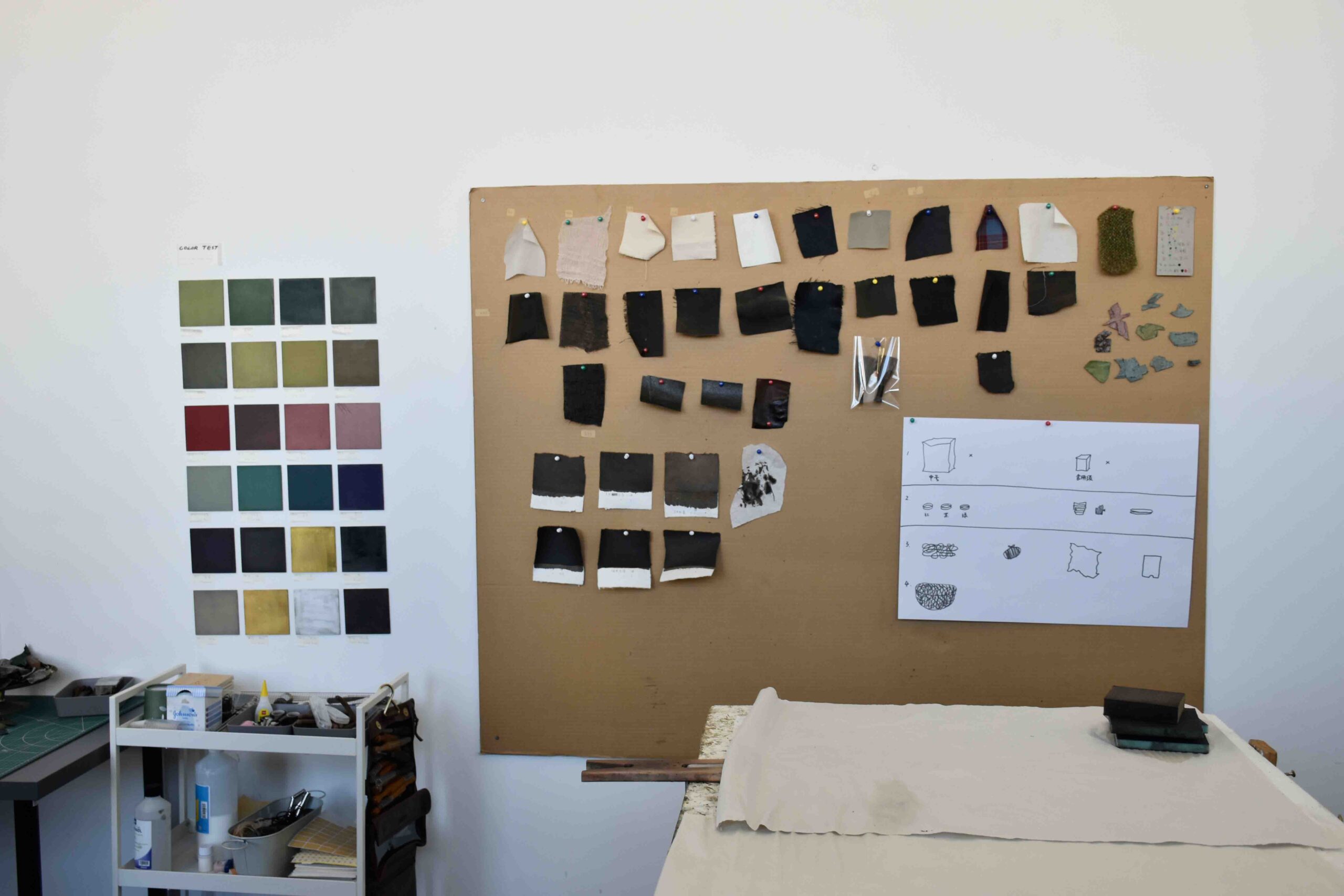
I started by experimenting on small wooden panels, trying to replicate that wall-like presence. Then I thought: how could I carry this memory with me? I tried covering the inside of a box, but it didn’t feel right. Eventually, I remembered a line from a Lubaina Himid exhibition I saw at the Tate Modern:
“We live in clothes, we live in buildings — do they fit us?” —Lubaina Himid
That made me realise—clothing could be architecture. A container. A walking structure. That was the moment I moved from wood to fabric.
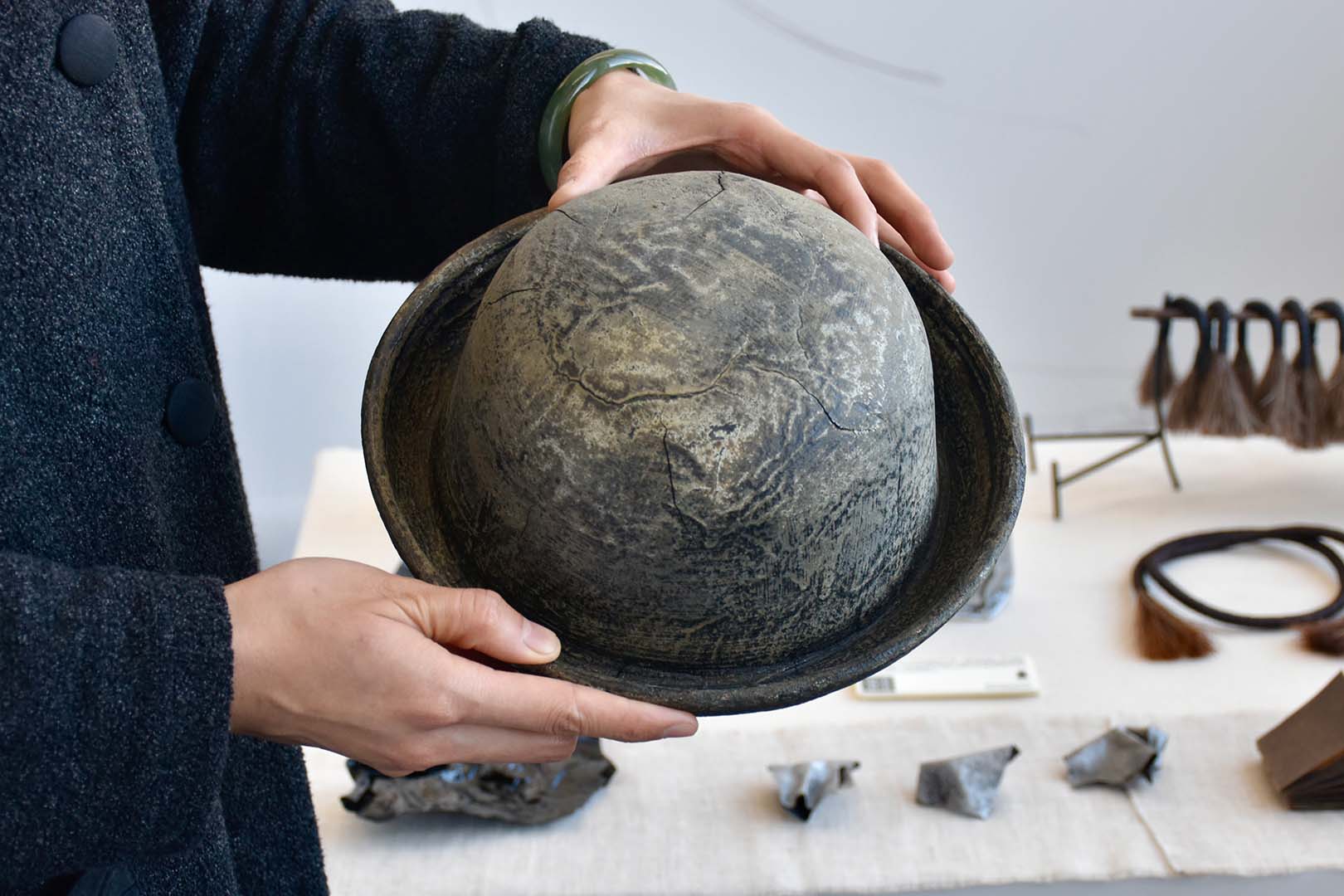
CM: The garments that you used in your series, such as the bowler hat and the shirts, are quite interesting. They look quite Western, almost Victorian. Was there a reason for this choice in clothing?
M: I didn’t overthink it. I needed a wearable form with an interior space, so I chose a top hat—practical, sculptural, and gender‑neutral. At university I’d bought six identical hats in different colors because I loved the shape and the styling flexibility.
The shirts were similar: plain, unisex, blank slates. I produced 70+ hats and shirts so that they could be rearranged during exhibitions—on walls, on the floor—to suggest fluidity. To me, gender, like these objects, should be dynamic, not fixed.
CM: You’ve explored the gendered expectations of growing up in China, and the significance lacquer holds on representing your old home. Has that house had a particular impact or meaning to you?
M: The strong urge of trying to replicate the walls of this old home came from noticing a gender bias in my family. I began noticing small signs—like my younger brother being given the larger room. I had also started getting more pressure from my family to conform to social expectations.
During my childhood, I didn’t have a strong sense of gender differences in my home. It felt like a neutral, almost genderless space. After we moved out and grew older that I started to notice gender inequality in my family, such as my younger brother getting the larger room, or increased pressure on me to conform to traditional roles. This contrast made me nostalgic for that earlier home, which in hindsight symbolised a space free from gender expectations. That’s why I felt a strong urge to replicate the feeling of that house in my work, because I later realised I had lost it.
One of my early artworks in London was inspired by my experience with hair. When I was 18, I had a short haircut, an almost men’s haircut/pixie cut. But, of course, my parents did not allow me to have shorter hair, so they made me get hair extensions. My artwork was a plant pot with lots of strands and branches growing from it. At the time, I had added a few different plants and tried connecting them to the original plant.
CM: I saw one of the pieces was a performance art and you were inviting people to write on your hand.
M: Yes, that piece was about the labels and stereotypes participants perceived about me. The idea of writing on my skin stems from this condition that would make me get hives occasionally. When “writing” on my skin, my skin gets really red…but it doesn’t hurt—it simply reddens and disappears within minutes. The act of having other people write as an act of the violence from being under the labels and stereotypes that were perceived of me.
CM: A lot of your pieces explore themes of freedom and breaking free from the mould. Would you consider your current stage as making peace and accepting your identity, or are you still in the phase of exploration?
M: Right now, I don’t feel gender or identity exploration is as central to my work as it once was. To me, because I have gained more understanding of my parents’ social structure and cultural context, I then realised it was not all their fault— it was never intentional, it’s purely societal. It was the only idea that they had grown up with and I had made peace with it. I currently just want to be/look like whatever I want.
CM: Your use of lacquer is interesting because it is a material that hardens, yet you describe it as fluid. Lacquer is rigid; fabric is soft. How do you reconcile that?
M: That tension is intentional. Fabric alone is flexible—full of possibilities. Lacquer alone is hard, protective, almost violent.
When I use lacquer as a material, in the process it requires layers on top of layers, and I have to wait for it to dry in the ideal temperature and humidity. When lacquer layers build up on fabric, they ‘fix’ the form, just as social norms gradually harden our fluid identities. Such as the high socks sculpture They, Them, Their II, (2024) displayed on the floor, the individual socks were actually built and layered on stocking, a very soft and gentle material in nature.
The combined object—soft core, hard shell—mirrors how gender is performed and enforced over an originally flexible self.

CM: How did your MA at RCA shape your growth? What comes next?
M: During the two‑year MA (plus grad diploma), I was adapting to an English environment, questioning family expectations, and evolving personally. Post‑graduation, those earlier tensions feel resolved—so I’ve turned fully to material research and qiqiqiqi (漆奇岂器) Studio, co‑founded with Siying Cui.
Post-graduation, I began to understand those earlier tensions not as problems to be solved, but as conditions to live with. This shift led me to explore materiality more deeply, as a way of thinking through material behaviour, slowness, and touch.
CM: Today we are very lucky to have Siying Cui, co-founder of qiqiqiqi Studio here in the interview as well. Would you like to tell us more about the studio?
Siying Cui (S): In our studio, our main area of interest is to explore the potential between combining two materials. We have been experimenting with lacquer with organic or biomaterials such as textiles, paper, fiber, and even horsehair.
Since ancient times, lacquer was presented as something intricate and extravagant, or presented as a very strong material. In doing experiments of combining lacquer with non-conventional materials, away from being a mere coating for containers.
Our motto is simple: 1 + 1 > 2—the combination yields qualities neither material has alone

CM: I do believe that this bio-hybrid lacquer material feels much lighter in person. It would be amazing for more people to experience your crafts.
Congratulations on qiqiqiqi Studio for being part of Unanchored Crafting @ London Craft Week!
qiqiqiqi: We’re thrilled to exhibit at Alsolike Gallery, 12–18 May 2025.Our qiqiqiqi Studio continues to trace the material, the sensorial, and the subtle links between objects and bodies, within this collective dialogue across metals, lacquer, enamel, CNC machining, and beyond.
Come see how craft becomes a language of exploration, a site of memory, fracture, and reconstruction.
Unanchored Crafting @ London Craft Week
12-18 May 2025
PV: 6-9 pm, 12 May
Alsolike Gallery, 16 Chance Street, London, E2 7JB
